Village cricket is a funny old game!
 John Arlott, infamous and sadly missed commentator for the BBC's Test Match Special, once noted that "villagers do not think that village cricket is funny". But, according to the Daily Telegraph, "compared with 'proper cricket', the village brand 'borders on the ridiculous - there's plenty of huff and puff as twenty-two odd-shaped men posture about the green like Test cricketers'''. That's perhaps, a typical view from the popular press; those that are far too busy to delve deeper for a proper story.
John Arlott, infamous and sadly missed commentator for the BBC's Test Match Special, once noted that "villagers do not think that village cricket is funny". But, according to the Daily Telegraph, "compared with 'proper cricket', the village brand 'borders on the ridiculous - there's plenty of huff and puff as twenty-two odd-shaped men posture about the green like Test cricketers'''. That's perhaps, a typical view from the popular press; those that are far too busy to delve deeper for a proper story.
They, of course, forget the even more oddly shaped umpires and the army of volunteers working behind the scenes.
Village cricket continues to perform an important function in the lives of the local inhabitants. Often the hub of village social life, they not only provide something for the youngsters to get involved in, but often progress young cricketers up through the ranks to first class cricket. Everyone, as they say, has to start somewhere.
It is believed that around forty percent of current English first class cricketers started out by playing for their local team, an important fact when one considers the demise of all sport in schools. Of course, the greater percentage still come from more privileged backgrounds, but the balance is shifting as the ECB and County boards are now providing more funding to grassroots cricket.
Again, according to the Telegraph, "one of the main reasons that village cricket is funny to watch is that everybody is encouraged to play, regardless of their skill with bat or ball. This fundamental principle sets it apart from the Australian only-play-to-win mentality."
Whilst the reality might be that enthusiasm counts for more than ability on the field of play, it still remains that the volunteers who keep village clubs going - from committees and captains to cake-makers and coaches - are the lifeblood of the sport. None more so than 'out in the middle', where the work of the groundsman often goes unnoticed and 'unhelped'.
These individuals, often former players who have taken on the role after retiring from playing, generally work alone, with the bare minimum of equipment, putting in long hours to ensure that the wickets are prepared to the best of their ability. Where once they had little or no reference point, they now have the benefit of various grassroots training courses, County trailers loaded with specialist machinery, the opportunity to seek advice on the Pitchcare message board - often given by professional groundsmen - and, of course, the ECB County Pitch Advisers to call on.
Our editor visits two local league rivals in Warwickshire - Long Itchington and Hunningham cricket clubs - to see how they are facing up to the challenge.
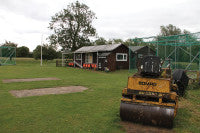 Situated on the banks of the river Itchen, from whence the village gets its name, the population of Long Itchington is ten times that of its near neighbour and cricket rivals, Hunningham.
Situated on the banks of the river Itchen, from whence the village gets its name, the population of Long Itchington is ten times that of its near neighbour and cricket rivals, Hunningham.
The club runs two senior Saturday league teams in the Cotswold Hills league, a senior Sunday side that plays friendlies only, and five junior teams at under 10, 11, 13, 15 and 17 age groups. Players have to live or have lived in the village, or been junior members to turn out for the club, unless a special invitation has been extended by the committee. Current playing membership stands at just over forty seniors and seventy juniors.
It is here that Steve Mitchell, John Deere's PR guru in the UK, played most of his cricket and where, whilst remaining a vice president of the club, he also coaches at the local school.
The ground is situated in a very rural setting where, until recently, sheep used to graze the outfield all year round. Now, they are confined to winter grazing on the outfield to help keep the grass down, whilst neighbouring cows are kept off the ground (and out of the nearby river) by electric fencing. The land belongs to a local farmer, and the club pay a peppercorn rent for its use.

In somewhat of a contrast to the smaller village of Hunningham, Long Itchington's pavilion is an old wooden building acquired from the Stoneleigh Royal Showground. It was transported in two halves and put back together on site.
There are no main services at the ground apart from a water supply; electricity is provided via a generator, whilst toilet waste is collected in a septic tank. Although old, the pavilion still offers all the necessary facilities for a cricket match. Recent improvements have seen showers installed to meet with league requirements. There are no bar facilities as, with six pubs in the village, it was deemed unnecessary!
Club President is Allen Hickling, who has been with the club since it reformed back in 1976, and he has been the driving force for much of that time.
Head Groundsman is Graham Foster, who is also 2nd XI captain (and a keen Pitchcare member). He is assisted by Steve Rawbone, one of the club's youth coaches, who also manages the under 11s.
 Graham has been a member since the club reformed in 1976, playing junior, then senior cricket since the age of sixteen. Now forty-nine and still playing and captaining the 2nd XI, he first got interested in the ground when he was eighteen, helping out by cutting the outfield with an old Massey Ferguson tractor with gang mowers. "At that time there wasn't any real preparation of wickets," says Graham. "The club's groundsman used to just cut a wicket out and roll it with a walk-behind, ex-council, path roller on the night before the game. There were certainly no autumn renovations!"
Graham has been a member since the club reformed in 1976, playing junior, then senior cricket since the age of sixteen. Now forty-nine and still playing and captaining the 2nd XI, he first got interested in the ground when he was eighteen, helping out by cutting the outfield with an old Massey Ferguson tractor with gang mowers. "At that time there wasn't any real preparation of wickets," says Graham. "The club's groundsman used to just cut a wicket out and roll it with a walk-behind, ex-council, path roller on the night before the game. There were certainly no autumn renovations!"
It was through talking to Karl Brotherhood - the head groundsman at Solihull School, and also a close friend - back in 1992, that Graham realised there was a bit more to groundmanship than had previously been carried out. "I always wondered why, as an opening bat, I was being hit on the hand or being bowled by a shooter!" comments Graham. "Something had to be done so, when the last groundsman retired, about ten years ago, I decided to take it on. A Graden was hired and, with advice from Karl, I started my first autumn renovation and have been doing the job ever since. Now I use our own scarifier, a Sisis Autorake, which I couldn't do without."
Graham and/or Steve can be seen at the ground most evenings during the summer preparing the ground for fixtures.
To assist Graham and Steve, the club operate a 'volunteer' rotation system, whereby current first team players have to make themselves available for a week at a time to carry out various tasks, like putting out boundary ropes, cones and other chores to help get the ground ready for weekend and evening matches.
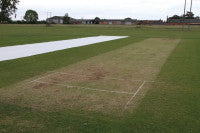 The square is built on Kaloam, and this season has probably been one of the best in terms of playability; all the prepared pitches seem to have had the best carry and bounce ever experienced. Indeed, ECB Pitch Advisor, Geoff Calcott (yes, he of Hunningham) rated the wicket 'a huge improvement'.
The square is built on Kaloam, and this season has probably been one of the best in terms of playability; all the prepared pitches seem to have had the best carry and bounce ever experienced. Indeed, ECB Pitch Advisor, Geoff Calcott (yes, he of Hunningham) rated the wicket 'a huge improvement'.
The machinery is very basic; old Atco mowers are used to cut the square, and a Sisis scarifier is used to keep thatch levels down. With Steve Mitchell's influence, and Karl Brotherhood's help in sourcing it, the club have recently bought a John Deere 300R ride-on rotary mower from Parks & Grounds Machinery to cut the outfield. The roller is an old Bomag, a tried and trusted road roller that "does a good job", according to Graham.
Graham carries out the end of season renovations himself, co-opting other members to help, undertaking the usual processes of scarifying, topdressing (eight bags per strip) and overseeding. As for aerating the square, this is done when hiring in suitable equipment and weather conditions allow.
Like most village cricket clubs, there seems to be precious time left in the week to maintain the square, especially with so much activity going on - the junior sides utilise the square Monday, Tuesday and Thursday, U17s have net practice on Fridays and the senior sides usually play on both days of the weekend.
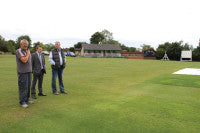 With a population that hovers around the two hundred mark, the village of Hunningham would seem an unlikely candidate to boast a thriving cricket club. However, the opposite is true, thanks to two Daves who are at the hub of the club; Chairman, Dave Mundy, and Pavilion Manager, Dave Reason.
With a population that hovers around the two hundred mark, the village of Hunningham would seem an unlikely candidate to boast a thriving cricket club. However, the opposite is true, thanks to two Daves who are at the hub of the club; Chairman, Dave Mundy, and Pavilion Manager, Dave Reason.
These two, along with several other dedicated club members have, in recent years, transformed the club and its facilities.
The village sits just south of a line between Leamington Spa and Rugby, in picturesque Warwickshire countryside. Members are drawn from the surrounding area as well as the village. These total forty adults and a buoyant junior membership of seventy.
In the late nineties, although the club was thriving, it was felt that, as they entered the new millennium, improvements needed to be made to attract more junior members that would become the lifeblood of the club in later years. So, the two Daves embarked on an ambitious project; to provide the club and the village with a social centre in the shape of a new clubhouse and bar.
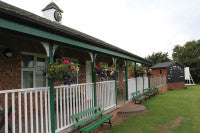 Their old wooden pavilion, whilst picturesque, was well past its sell by date and did not meet the needs of an ambitious club. So, in 2000, they began raising funds and, over the following ten years, have completely rebuilt the pavilion/clubhouse and changing room areas.
Their old wooden pavilion, whilst picturesque, was well past its sell by date and did not meet the needs of an ambitious club. So, in 2000, they began raising funds and, over the following ten years, have completely rebuilt the pavilion/clubhouse and changing room areas.
The work was undertaken in two phases. Phase one (2002-2004) saw the rebuilding of the changing rooms and kitchen facilities, at a cost of £50,000, with most of the money being raised by the club, and the majority of the work being undertaken by the members, adopting a beg, borrow and steal approach to the whole project.
Phase two began in 2008, with the aim of improving the main room and bar areas. This required an additional £40,000 and, again, the club raised a good percentage of the money themselves by arranging loans and organising fundraising events. However, this time, they were also fortunate to receive £14,000 from Warwick District Council and £2,000 from the local Parish Council.
By the summer of 2009, the whole clubhouse had been transformed into a modern and much improved facility. Whilst it had been a hard slog, the club are now reaping the benefits, with the facilities open most days of the week to accommodate the increased usage.
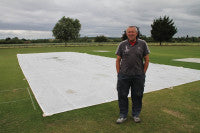
With the clubhouse issues resolved, Hunningham turned their attention to the playing facilities. If new players were to be attracted, these also had to be improved.
Dave Reason had been the groundsman for a number of years, but had to give up three years ago due to work commitments. His successor was Simon Greaves who also had to retire at the end of last year, leaving just a group of willing volunteers with little or no experience.
So, the club has hired the services of Geoff Calcott, ECB pitch adviser for Warwickshire, sportsturf contractor, Pitchcare trainer and contributor to this magazine, who is advising and assisting on the management of the square and outfield.
Geoff has been a self-employed sportsground contractor since 1984 and has worked at many venues covering a variety sports, including rugby, football and cricket. He currently looks after King Edward VI School grounds in Stratford, and helps to carry out end of season renovations at more than twenty cricket clubs within the county.
 Hunningham pay a fee for Geoff's services, which includes pre and post season activities and also regular visits to apply fertilisers and tonics, whilst also keeping an eye on the maintenance carried out by the club's volunteer groundsmen.
Hunningham pay a fee for Geoff's services, which includes pre and post season activities and also regular visits to apply fertilisers and tonics, whilst also keeping an eye on the maintenance carried out by the club's volunteer groundsmen.
The club's square provides seven senior and three junior strips, all built on Boughton County loam, so it is important that, with the amount of fixtures being played, they are repaired and rotated 'sensibly'. Six games per track is the norm, and this is where an improved maintenance regime will certainly help.
With the club's finances now on a solid footing, they have invested in machinery. In the shed is a Ransomes 213D Triple mower for the outfield, a Ransomes Auto Certes 51 cylinder mower for prepping the wickets, and a Ransomes Marquess 61 for cutting the square. A rotary mower and strimmer are used for cutting perimeter areas and around obstacles, whilst an Auto-roller, acquired from Worcestershire County Cricket Club, is used for rolling the square. Geoff Calcott supplies whatever is needed in terms of aeration and scarifying equipment. They have also invested in two Climate Cover Systems from total-play Ltd, along with roll on roll off covers.
The club are now running junior teams at all levels from under 10 to under 17, the 1st XI competing in the Warwickshire County League, and the clubhouse more than earning its keep. Dave Mundy and Dave Reason have every reason to be delighted with their efforts to date. And, with the addition of the services of Geoff, they know the ground is in good hands. They have already seen improvements in the ground's overall presentation and how the square has been playing, and hope it will become a long term partnership to ensure that cricket will be an attraction for the next generation of village cricketers.
With the club celebrating its seventy-fifth anniversary this year, the future certainly looks bright for this 'small' village club.
FOOTNOTE: It is imperative that village cricket clubs continue to survive; they are the catalyst for providing the next generation of cricketers to go on to represent their counties or country.
Both Hunningham and Long Itchington are a fair representation of village cricket life the length and breadth of the UK, in the way they provide the opportunity for local people to get involved in the game.
These clubs also provide a valuable service to the community, encouraging young people to learn the life skills that are part and parcel of playing for a sports club. It gives them something constructive to do in the long, balmy summer's evenings (I wish, Ed).
And, how do you put a price on what the villagers themselves gain?
However, everyone, cricketers and villagers alike, need to understand that there is a cost to playing cricket in terms of pitch provision. The ECB reckon that the minimum cost of putting on any sort of cricket match is £200, yet I still see far too many clubs charging next to nothing for being an active member. Surely, it is about time people paid a fair price or, better still, devoted some of their time to helping their club remain viable.
Hunningham CC and Long Itchington CC are prime examples of what can be achieved with a team of devoted members.
